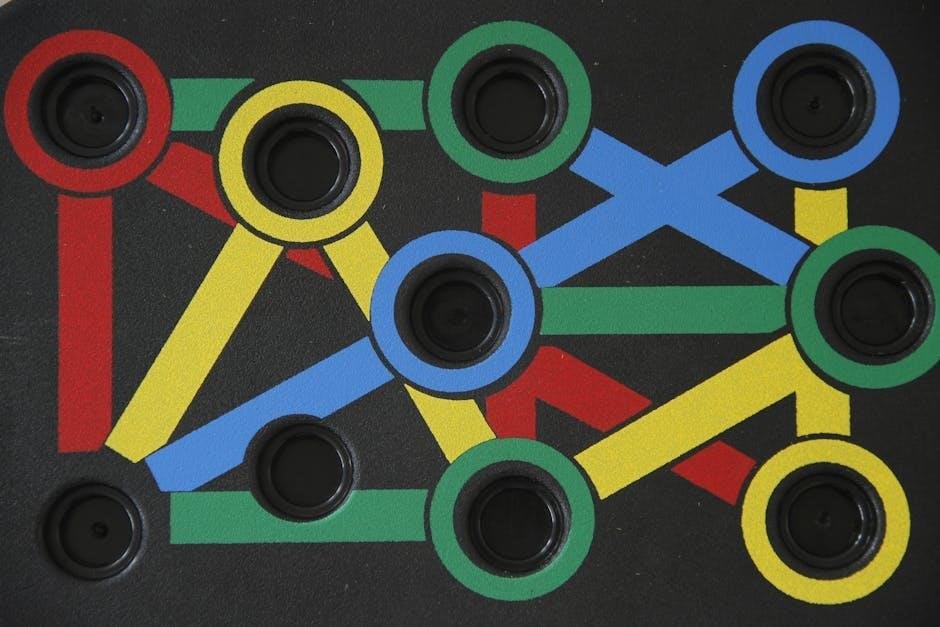A summary graphic organizer is a visual tool designed to help students structure and organize information effectively․ It simplifies complex texts into key points and main ideas, making learning more accessible and engaging for all students․
1․1 What is a Summary Graphic Organizer?
A summary graphic organizer is a visual tool designed to help individuals organize and synthesize information effectively․ It typically consists of structured sections or boxes that guide users in identifying main ideas, supporting details, and key concepts from a text or topic․ These organizers are often used in educational settings to enhance comprehension and retention․ They come in various formats, such as Venn diagrams, concept maps, or chart-like structures, making complex information easier to digest․ By providing a clear framework, summary graphic organizers enable learners to break down content into manageable parts, fostering deeper understanding and effective summarization skills․
1․2 Importance of Using Graphic Organizers for Summarizing
Using graphic organizers for summarizing is essential for enhancing learning outcomes․ These tools help students visually structure information, making complex concepts more accessible․ By breaking down texts into key elements, learners improve their ability to identify main ideas and supporting details․ Graphic organizers also foster critical thinking and creativity, as they encourage users to connect ideas and see relationships․ Additionally, they promote active engagement with material, leading to better retention and understanding․ For educators, these organizers provide a clear framework to assess students’ comprehension and guide instruction effectively, making them invaluable in diverse educational settings․

Types of Summary Graphic Organizers
2․1 Somebody-Wanted-But-So-Then (SWBST) Organizer
The SWBST Organizer is a structured tool designed to help students create effective summaries by focusing on five key elements: Somebody, Wanted, But, So, and Then․ This method aids in identifying the main characters, their goals, the obstacles they face, the actions they take, and the resolution of the story․ Each component guides the summarization process, ensuring that all essential parts of the narrative are covered without unnecessary details․ This organizer is particularly beneficial for students who struggle with summarizing, as it provides a clear and organized framework to follow․ It is also versatile, suitable for various age groups and story complexities, and can be adapted to include additional details or quotes for deeper analysis․
2․2 Cause-and-Effect Graphic Organizers
Cause-and-effect graphic organizers are tools designed to help students identify and visualize relationships between events and their outcomes․ These organizers typically feature two main sections: one for causes and one for effects, with space to explore how they are connected․ They are particularly useful for analyzing complex texts or historical events, making it easier for students to understand how actions lead to consequences․ This organizer enhances critical thinking and analytical skills, while its visual structure helps in organizing information effectively․ Available as PDFs, they can be easily printed and customized for various educational needs․
2․3 Compare and Contrast Organizers
Compare and contrast graphic organizers are structured tools that help students analyze similarities and differences between two or more concepts, ideas, or characters․ These organizers often feature columns or sections where students can list shared traits and unique aspects․ They are ideal for improving critical thinking and fostering clear, organized writing․ Available in PDF formats, compare and contrast organizers are versatile and can be adapted to various subjects, such as literature, science, or social studies․ Their visual format makes complex comparisons easier to understand and helps students develop structured arguments․

Benefits of Using Summary Graphic Organizers
3․1 Improved Reading Comprehension
3․2 Enhanced Writing Skills
3․3 Better Retention of Information
Digital Versions of Summary Graphic Organizers

Digital versions of summary graphic organizers offer flexibility, customization, and collaboration features, enhancing learning experiences․ They align seamlessly with PDF resources, making education interactive and accessible․
4․1 Google Classroom-Compatible Organizers
Google Classroom-compatible summary graphic organizers streamline lesson delivery and student engagement․ These digital tools allow seamless sharing, real-time collaboration, and automatic saving, making assignments and feedback efficient․ Teachers can easily distribute customizable templates aligned with PDF resources, ensuring accessibility for all learners․ Features like comment banks and rubrics enhance assessment, while version history tracks progress․ These organizers reduce paper waste and promote organized digital workflows, catering to modern classroom needs and fostering a more interactive learning environment․
4․2 Interactive Digital Templates
Interactive digital templates for summary graphic organizers offer dynamic and engaging ways to enhance learning․ These templates allow students to type directly into fields, drag and drop content, and incorporate multimedia elements like images or audio․ They foster creativity and active participation, making complex concepts more accessible․ Real-time collaboration features enable group work and peer feedback, while interactive checks for understanding help teachers monitor progress․ Such tools are particularly effective for visual learners and those who benefit from hands-on activities, providing a flexible and adaptable approach to summarizing information․

How to Choose the Right Summary Graphic Organizer
Selecting the right summary graphic organizer involves aligning it with learning goals, matching content complexity, and ensuring it meets the needs and skill levels of students․
5․1 Matching Organizers to Learning Objectives
Matching graphic organizers to learning objectives ensures they effectively support instructional goals․ Teachers should first identify the specific skills or content students need to master․ Then, they can select an organizer that aligns with these objectives, such as a Venn diagram for comparisons or a cause-and-effect chart for analyzing relationships․ This strategic selection enhances the clarity of the lesson and helps students organize information in a way that directly ties to what they are expected to learn․ By aligning tools with goals, educators create a more focused and impactful learning experience․
5․2 Selecting Based on Student Needs
Selecting summary graphic organizers based on student needs ensures that all learners can engage effectively․ Teachers should consider students’ skill levels, learning styles, and any special requirements․ For example, visual learners may benefit from charts and diagrams, while struggling readers might need simpler, more structured templates․ Additionally, differentiated instruction can be supported by offering multiple organizer options tailored to various abilities․ By aligning the tool with individual or group needs, educators can maximize understanding and participation, ensuring that every student has the opportunity to succeed in organizing and summarizing information effectively․

Popular Resources for Summary Graphic Organizers
Popular resources include Teachers Pay Teachers (TPT), Canva, and free printable templates for K-12 education, offering customizable and ready-to-use summary graphic organizer PDFs for various subjects․
- Teachers Pay Teachers (TPT)
- Canva Templates
- Free Printable PDFs
6․1 Free Printable Templates for K-12 Education
Free printable summary graphic organizer PDFs are widely available online, designed for K-12 education․ Websites like Teachers Pay Teachers and Education․com offer customizable templates tailored to various subjects and grade levels․ These templates are ideal for teachers seeking to save time while providing structured tools for students to organize ideas and concepts․ Many templates are visually engaging, with options to adapt to different learning needs․ They are downloadable in PDF format, making them easy to print and distribute in classrooms․ This resource is a cost-effective way to enhance learning and teaching experiences․
- Available for various grade levels
- Customizable to suit different subjects
- Downloadable in PDF format
- Visually appealing and easy to use
6․2 Teachers Pay Teachers (TPT) Resources
Teachers Pay Teachers (TPT) offers a wide range of summary graphic organizer PDFs designed for K-12 education․ These resources are created by educators and cater to diverse teaching needs․ Many templates are customizable, allowing teachers to tailor them to specific lessons or student requirements․ TPT provides options for various subjects, making it a versatile platform for educators․ The marketplace includes both free and paid resources, ensuring accessibility for all budgets․ These organizers are often visually appealing and structured to enhance student engagement and understanding․
- Customizable templates for different subjects
- Suitable for a wide range of grade levels
- Both free and paid options available
- Created by experienced educators
6․3 Canva’s Customizable Graphic Organizer Templates
Canva offers a variety of customizable graphic organizer templates that are perfect for creating summary graphic organizer PDFs․ Its user-friendly interface allows educators to design visually appealing and structured templates․ With a wide range of fonts, colors, and design elements, teachers can tailor organizers to suit specific lessons or student needs․ Canva also provides collaboration tools, enabling educators to share and edit templates with colleagues․ While some templates are free, others require a Canva Pro subscription․ This platform is ideal for creating professional-looking summary organizers for diverse educational purposes․
- Customizable templates with design flexibility
- Collaboration features for educators
- Suitable for various grade levels and subjects
- Both free and premium options available

Using Summary Graphic Organizers in the Classroom
Teachers can effectively integrate summary graphic organizers into daily lessons to enhance learning and engagement․ These tools help students organize ideas, visualize relationships, and retain information better․ By incorporating organizers into lesson plans, educators promote active learning and critical thinking․ They can be used for group activities, individual assignments, or interactive discussions, making them versatile for diverse teaching strategies․
- Promotes active learning and critical thinking
- Enhances classroom engagement
- Supports diverse teaching strategies
7․1 Integrating Organizers into Lesson Plans
Integrating summary graphic organizers into lesson plans can be seamless and effective․ Start by aligning the organizer with the day’s learning objectives to ensure relevance․ For example, use a cause-and-effect organizer during a science lesson or a SWBST (Somebody-Wanted-But-So-Then) organizer for literature analysis․ Incorporate organizers as a pre-reading activity to guide students or as a post-reading tool for reflection․ Digital versions, like PDFs, can be easily shared and customized․ By structuring lessons around these organizers, teachers create a clear framework for students to engage with material, fostering deeper understanding and active participation in the classroom․
- Align with learning objectives
- Use for pre- or post-reading activities
- Customize for different subjects
7․2 Differentiated Instruction with Graphic Organizers
Differentiated instruction is made easier with summary graphic organizers, as they cater to diverse learning needs․ Teachers can adapt organizers to suit varying skill levels, such as simplifying templates for struggling students or adding complexity for advanced learners․ PDF versions allow for easy customization, enabling educators to tailor content for individual or small group instruction․ Additionally, graphic organizers support visual, kinesthetic, and auditory learners by providing structured yet flexible frameworks․ This adaptability ensures all students can engage effectively, fostering an inclusive and dynamic learning environment that addresses different abilities and learning styles simultaneously․
- Customize templates for skill levels
- Support visual, kinesthetic, and auditory learners
- Facilitate small group or individual instruction

Student Feedback and Reviews
Students often praise summary graphic organizers for making complex information easier to digest․ Many report improved understanding and retention of material, especially with PDF formats․
8․1 Positive Impact on Learning
Students consistently report that summary graphic organizers, particularly in PDF formats, have a profoundly positive impact on their learning․ These tools help break down complex information into digestible parts, fostering better understanding and retention․ The visual structure of PDF organizers allows learners to connect ideas more effectively, enhancing their ability to analyze and synthesize content․ Many students appreciate how these organizers guide them in identifying key details, making study sessions more efficient․ The clarity and organization provided by PDF graphic organizers have been shown to boost confidence and performance across various subjects․
8․2 Ease of Use for Diverse Student Populations

Addressing Different Learning Needs
9․1 Graphic Organizers for Students with Learning Difficulties
9․2 Organizers for English Language Learners
10․1 Key Takeaways
10․2 Encouragement to Implement Graphic Organizers
Implementing summary graphic organizers offers a transformative approach to teaching and learning․ These tools not only enhance engagement but also improve comprehension and critical thinking skills․ Their accessibility in PDF formats makes them easy to share and use in various classroom settings․ Educators are encouraged to embrace these organizers as they cater to diverse learning styles and subjects․ By integrating them into daily lessons, teachers can create a more inclusive and effective learning environment․ Start with free templates and gradually explore digital options to maximize their benefits and support student success․

